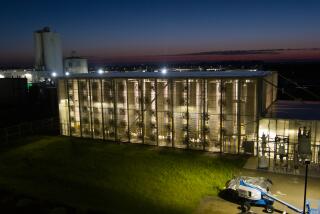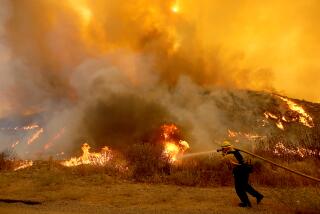How Mother Earth Works: Controversial Theory Debated at UCSD Scientific Conference
For climate researcher Richard C.J. Somerville, a cloud does more than spoil a picnic. For geochemist Robin Keir, tiny one-celled plants floating in the sea are more than food for whales.
A small change in cloud cover can cool the Earth, a phenomenon that may account for the fact that the carbon-dioxide-induced global warming known as the greenhouse effect has not been as severe as otherwise would be expected, Somerville has found. And one-celled phytoplankton may have helped cool the climate during the last Ice Age by consuming carbon dioxide faster than volcanoes could release it, Keir suggests.
The two scientists at UC San Diegoâs Scripps Institution of Oceanography see both as parts of an emerging picture of how climate and life influence each other--and what that might mean for the planetâs future.
Somerville and Keir described their research at a decidedly unconventional conference at the San Diego Princess hotel last week, the Chapman Conference on the Gaia Hypothesis.
Named after the Greek Earth goddess, Gaia is a controversial notion of Earth as a living organism whose parts work together--much as those in a human body do--to sustain life on the planet. It represents a radical departure from the traditional view of living things as passively reacting to their physical environment.
âThe air, the oceans and the rocks are all either made by living organisms, or else changed by their presence,â the father of Gaia, British scientist James Lovelock, has written. âOrganisms do not just âadaptâ to a dead world determined by physics and chemistry alone. They live with a world that is the breath and bones of their ancestors and that they are now sustaining.â
In such a framework, clouds that cool off the planet or microorganisms that consume carbon dioxide play a critical role.
Came Out With a Flourish
Although born in the shadow of the awakening environmental movement in the early 1970s, and nurtured since then mostly by a collection of what one scientist called âeco-freaks,â Gaia came out of the closet with a flourish at last weekâs meeting.
There to greet her were an international collection of noted atmospheric, earth and biological scientists who, for the first time, met to debate the merits of an idea that many of them have derided for years.
That the meeting was held by the stodgy American Geophysical Union at all was a source of embarrassment for and criticism from some scientists who declined to attend.
âGaia has no scientific basis . . . It has no business being the subject of a Chapman conference,â wrote Wallace Broecker, of Columbia Universityâs Lamont-Doherty Geological Observatory in a letter to a conference organizer, Stephen H. Schneider.
Schneider is head of climate systems research at the National Center for Atmospheric Research in Boulder, Colo.
Attracted 162 Scientists
But Schneider was unruffled--especially since the meeting did attract 162 scientists, including some of the leaders in geophysical research.
âThese are people like Dick Holland.
These are members of the National Academy of Sciences. These are not flakes,â Schneider said. âAnd theyâre coming because they, too, think Gaia should come out of the fringes.â
Holland, a geochemist at Harvard University, laughingly acknowledged his role as one of the hard-core Gaia detractors at the meeting, but said he still found it useful.
âIt brought together a lot of people, a lot of different disciplines, who asked the question, âWhat is the role of the biosphere in the operation of the atmosphere and the oceans?â â Holland said.
Stanford University population biologist Paul R. Ehrlich, who discounted Gaia in a keynote address, said Lovelock has nevertheless made a significant contribution with his ideas.
âI think what will come out of it is that the hypothesis has been very important in a poetic sense, of calling attention to the importance of organisms to the entire global environment,â Ehrlich said.
Indeed, it was that underlying concept of the Earth as one unified system that apparently drew so many noted researchers together to debate--sometimes contentiously--specific aspects of the Gaia hypothesis:
If the Earth is a living organism, what are its boundaries? How does one solve the chicken-egg proposition of whether an organismâs evolutionary adaptation caused a change in the environment or resulted from it? If different forms of life are cooperating to keep Gaia healthy, will one life form âsacrificeâ itself for the good of another--as when ancient oxygen-hating bacteria produced so much oxygen that they could no longer live in most of the world? (This same oxygen made life as we know it possible.)
But consistently the scientists asked: Is the Gaia idea more of an intuitive metaphysical concept than a scientific hypothesis that can be tested?
The arguments stem partly from the fact that nearly everyone has a different idea about the Gaia hypothesis. Lovelockâs idea of life as purposefully changing its environment to promote the overall well-being of the planet cannot be tested scientifically, the gathering agreed.
But it may be possible to test other versions of the hypothesis, such as this one offered by Lynn Margulis, a Lovelock collaborator and a microbiologist at Boston University:
âThe atmosphere and probably the surface sediments of the planet Earth are regulated by the biota, the sum of all the living organisms. Specifically, the composition of the reactive gases, the acidity/alkalinity, the temperature, the salinity of the oceans, the deposition of metal ores like gold and iron, and maybe even aspects of plate tectonics may also be affected and in fact even regulated by the biota.â
Some colleagues could, and did, quibble with Margulisâ definition. But any version of the Gaia concept does provide a useful backdrop for the new and rapidly growing study of global systems, they said.
Over the last few years, more scientists who formerly concentrated on the minutiae of their fields have turned from a micro to a macro view, made possible largely by powerful computers that allow them to create âmodelsâ of systems. For example, a climate researcher such as Scrippsâ Somerville can plug basic knowledge of how clouds form and how much light they reflect into a model to see how a change in cloudiness would affect the Earthâs temperature.
In climate research, scientists not only want to know the answer to such broad questions but also to discover how different climate mechanisms get turned on and off.
In developing the Gaia concept, Lovelock and Margulis theorized that Gaia takes care of herself through âfeedback loopsâ that can intensify or ease the effects of environmental changes. Much of the San Diego meeting involved looking at apparent feedback loops that have emerged so far.
Most notable among them was the role of phytoplankton as a natural thermostat regulating the planetâs temperature.
A research group led by Robert J. Charlson at the University of Washington reported last year that these one-celled oceanic plants were producing a gas that was the primary source over the ocean of cloud condensation nuclei, the tiny particles around which cloud droplets form.
The microscopic plants can, in effect, cool themselves off by producing more of the dimethylsulfide gas and make the sky above them cloudier. Because so little is known about individual phytoplankton species, no one yet knows whether the resulting cooler temperatures and lower light level turn down the phytoplanktonâs gas-making machinery. That would have to be shown before an entire feedback cycle would be proved.
But, in terms of Gaia, even this preliminary evidence of one-celled organisms serving a planetary purpose is considered significant. It also gives urgency to environmentalistsâ concerns that all organisms have a role to play in keeping the world habitable.
âEarth would be several degrees warmer if all the phytoplankton were killed off,â Charlson said.
There is also speculation that, perhaps, phytoplankton-induced cloudiness is why the man-made buildup of carbon dioxide in the Earthâs atmosphere so far has warmed the planet only half as much as computer models would otherwise predict.
But lest anyone think that revving up the phytoplankton will turn off the greenhouse effect, geophysicist Glenn Shaw of the University of Alaska warns that such a strategy might result in drought. âThe finer-dropped cloud thatâs produced is less likely to rain,â he pointed out.
Other pieces of feedback loops discussed at the meeting included:
- Larger algae in the ocean produce methyl iodide gas, which, it has been suggested, plays a major role in oxidizing the dimethylsulfide into the particles around which the cloud droplets form.
- Venus and Mars provide opposing examples of the importance of geological processes in the Earthâs carbon-dioxide cycle, which is thought to regulate the planetâs temperature and make it habitable. In the cycle, insulating carbon dioxide is dissolved in rainwater, then stored in carbonate rocks. Erosion restores the mineral to the ocean, where it is incorporated into animal shells, drops to the bottom of the sea, and is subducted, or drawn down, into the Earth as plates of crust move. Finally, it is liberated by volcanoes as carbon dioxide gas, to be recycled again.
But even if there was once life on Mars, there was no subduction to recycle carbon dioxide into the atmosphere, said Raymond Siever of Harvard University. Eventually its water dried up and it became a cold, lifeless planet.
In contrast, it has been suggested that the absence of life on Venus to use carbon dioxide for photosynthesis resulted in a huge carbon dioxide buildup. This made the planet so hot that its crust could never become cool enough to subduct, leaving no way to get rid of carbon dioxide and sealing the planetâs fate.
- Some scientists suspect that, whenever the oxygen concentration in our atmosphere becomes too high, naturally occurring forest fires help re-establish the oxygen balance. Because the charred trees and shrubs are no longer using phosphorous, a crucial element for growth, there is more phosphorus runoff to the oceans. Marine plants use that nutrient less efficiently than land plants do, so there would be less oxygen going into the atmosphere, according to Lee R. Kump of Pennsylvania State University.
Such mechanisms are far from being proven, however, and the many variables in living systems will make that difficult to do. However, the conference provided a necessary forum for thinking in such terms, Margulis said.
âThat in itself is a remarkable innovation,â she said, âbecause what theyâre doing is considering the effect of the biota out loud, in ways that were much harder to do previously.â
For his part, after spending 16 years promoting the Gaia concept, Lovelock said heâs satisfied that it can survive without him; he plans to leave the Gaia field by yearâs end. âAs soon as thereâs a literature on a subject, then itâs time to leave it,â Lovelock said. âIt gets to the dotting of iâs and the crossing of tâs. Thereâs nothing more tedious than having to read all the past papers and worrying about whether youâre going to offend somebody.â
Schneider points out that the conference was much more than an academic exercise.
âIf we canât explain how the air and the trees and the rocks and the birds and the oceans and us got here, and what it was like during the transition, and we canât build models to represent how all this came about, then how are we going to have any credibility telling society to make the trillion-dollar decision to switch away from (fossil fuels) in the next century because of our own pollution?â Schneider said.
âWe have to use the same model to forecast the future that we have to use to explain the past. And only to the extent that we can explain the past do we have any credibility in forecasting the future.â






